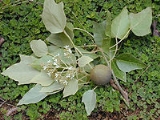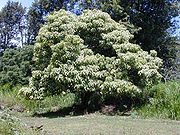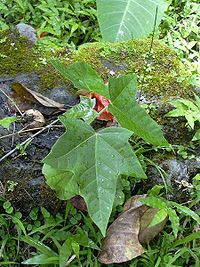
Aleurites
Encyclopedia
Aleurites is a small arborescent genus of flowering plant
s in the tropical and subtropical regions of Asia
, the Pacific and South America
, belonging to the spurge family Euphorbiaceae
.
These monoecious, evergreen tree
s are perennials
or semi-perennials. These are large trees, 15–40 m (49.2–131.2 ft) tall, with spreading drooping and rising branches.
The leaves
are alternate, lobate, ovate to ovate-lanceolate with minute stipules. They are pubescent on both sides when young, but in a later stage they become glabrous.
 The inflorescence
The inflorescence
consists of terminal plumes of small, creamy white bell-shaped fragrant flower
s, branching from the base. The flowers are usually bisexual
, with a solitary pistillate flower at the end of each major axis. The lateral cymes are staminate. There are five or six imbricate petals. The staminate flowers are mostly longer and thinner than the pistillate flowers, with 17-32 glabrous stamen
s in four whorls. The pistillate flowers have a superior ovary
.
The fruit
s are rather large drupe
s with a fleshy exocarp and a thin, woody endocarp. They vary in shape, according to the numbers of developed locule
s. They contain oleiferous, poison
ous seed
s.
The oil has been used as a paraffin
, lubricant
and as a constituent of varnish
, paint
and soap
. Once poisonous substances are removed, it can be used as a cooking oil
Some deciduous Chinese
species are now classified under a separate genus Vernicia
.
The name Aleurites is derived from a Greek
word meaning "wheaten flour", because of the appearance of the lower surface of the leaf.
(), occurring from tropical Asia, the Pacific, from India
to China
and Polynesia
, Australia
and New Zealand
. Some botanists only recognize two species, and .

Flowering plant
The flowering plants , also known as Angiospermae or Magnoliophyta, are the most diverse group of land plants. Angiosperms are seed-producing plants like the gymnosperms and can be distinguished from the gymnosperms by a series of synapomorphies...
s in the tropical and subtropical regions of Asia
Asia
Asia is the world's largest and most populous continent, located primarily in the eastern and northern hemispheres. It covers 8.7% of the Earth's total surface area and with approximately 3.879 billion people, it hosts 60% of the world's current human population...
, the Pacific and South America
South America
South America is a continent situated in the Western Hemisphere, mostly in the Southern Hemisphere, with a relatively small portion in the Northern Hemisphere. The continent is also considered a subcontinent of the Americas. It is bordered on the west by the Pacific Ocean and on the north and east...
, belonging to the spurge family Euphorbiaceae
Euphorbiaceae
Euphorbiaceae, the Spurge family are a large family of flowering plants with 300 genera and around 7,500 species. Most are herbs, but some, especially in the tropics, are also shrubs or trees. Some are succulent and resemble cacti....
.
These monoecious, evergreen tree
Tree
A tree is a perennial woody plant. It is most often defined as a woody plant that has many secondary branches supported clear of the ground on a single main stem or trunk with clear apical dominance. A minimum height specification at maturity is cited by some authors, varying from 3 m to...
s are perennials
Perennial plant
A perennial plant or simply perennial is a plant that lives for more than two years. The term is often used to differentiate a plant from shorter lived annuals and biennials. The term is sometimes misused by commercial gardeners or horticulturalists to describe only herbaceous perennials...
or semi-perennials. These are large trees, 15–40 m (49.2–131.2 ft) tall, with spreading drooping and rising branches.
The leaves
Leaf
A leaf is an organ of a vascular plant, as defined in botanical terms, and in particular in plant morphology. Foliage is a mass noun that refers to leaves as a feature of plants....
are alternate, lobate, ovate to ovate-lanceolate with minute stipules. They are pubescent on both sides when young, but in a later stage they become glabrous.

Inflorescence
An inflorescence is a group or cluster of flowers arranged on a stem that is composed of a main branch or a complicated arrangement of branches. Strictly, it is the part of the shoot of seed plants where flowers are formed and which is accordingly modified...
consists of terminal plumes of small, creamy white bell-shaped fragrant flower
Flower
A flower, sometimes known as a bloom or blossom, is the reproductive structure found in flowering plants . The biological function of a flower is to effect reproduction, usually by providing a mechanism for the union of sperm with eggs...
s, branching from the base. The flowers are usually bisexual
Plant sexuality
Plant sexuality covers the wide variety of sexual reproduction systems found across the plant kingdom. This article describes morphological aspects of sexual reproduction of plants....
, with a solitary pistillate flower at the end of each major axis. The lateral cymes are staminate. There are five or six imbricate petals. The staminate flowers are mostly longer and thinner than the pistillate flowers, with 17-32 glabrous stamen
Stamen
The stamen is the pollen producing reproductive organ of a flower...
s in four whorls. The pistillate flowers have a superior ovary
Ovary (plants)
In the flowering plants, an ovary is a part of the female reproductive organ of the flower or gynoecium. Specifically, it is the part of the pistil which holds the ovule and is located above or below or at the point of connection with the base of the petals and sepals...
.
The fruit
Fruit
In broad terms, a fruit is a structure of a plant that contains its seeds.The term has different meanings dependent on context. In non-technical usage, such as food preparation, fruit normally means the fleshy seed-associated structures of certain plants that are sweet and edible in the raw state,...
s are rather large drupe
Drupe
In botany, a drupe is a fruit in which an outer fleshy part surrounds a shell of hardened endocarp with a seed inside. These fruits develop from a single carpel, and mostly from flowers with superior ovaries...
s with a fleshy exocarp and a thin, woody endocarp. They vary in shape, according to the numbers of developed locule
Locule
A locule is a small cavity or compartment within an organ or part of an organism ....
s. They contain oleiferous, poison
Poison
In the context of biology, poisons are substances that can cause disturbances to organisms, usually by chemical reaction or other activity on the molecular scale, when a sufficient quantity is absorbed by an organism....
ous seed
Seed
A seed is a small embryonic plant enclosed in a covering called the seed coat, usually with some stored food. It is the product of the ripened ovule of gymnosperm and angiosperm plants which occurs after fertilization and some growth within the mother plant...
s.
The oil has been used as a paraffin
Paraffin
In chemistry, paraffin is a term that can be used synonymously with "alkane", indicating hydrocarbons with the general formula CnH2n+2. Paraffin wax refers to a mixture of alkanes that falls within the 20 ≤ n ≤ 40 range; they are found in the solid state at room temperature and begin to enter the...
, lubricant
Lubricant
A lubricant is a substance introduced to reduce friction between moving surfaces. It may also have the function of transporting foreign particles and of distributing heat...
and as a constituent of varnish
Varnish
Varnish is a transparent, hard, protective finish or film primarily used in wood finishing but also for other materials. Varnish is traditionally a combination of a drying oil, a resin, and a thinner or solvent. Varnish finishes are usually glossy but may be designed to produce satin or semi-gloss...
, paint
Paint
Paint is any liquid, liquefiable, or mastic composition which after application to a substrate in a thin layer is converted to an opaque solid film. One may also consider the digital mimicry thereof...
and soap
Soap
In chemistry, soap is a salt of a fatty acid.IUPAC. "" Compendium of Chemical Terminology, 2nd ed. . Compiled by A. D. McNaught and A. Wilkinson. Blackwell Scientific Publications, Oxford . XML on-line corrected version: created by M. Nic, J. Jirat, B. Kosata; updates compiled by A. Jenkins. ISBN...
. Once poisonous substances are removed, it can be used as a cooking oil
Cooking oil
Cooking oil is purified fat of plant origin, which is usually liquid at room temperature ....
Some deciduous Chinese
China
Chinese civilization may refer to:* China for more general discussion of the country.* Chinese culture* Greater China, the transnational community of ethnic Chinese.* History of China* Sinosphere, the area historically affected by Chinese culture...
species are now classified under a separate genus Vernicia
Vernicia
The genus Vernicia, commonly referred to as Tung or Tung-oil Tree, is a genus in the spurge family Euphorbiaceae, comprising three species, native to eastern and southeastern Asia....
.
The name Aleurites is derived from a Greek
Greek language
Greek is an independent branch of the Indo-European family of languages. Native to the southern Balkans, it has the longest documented history of any Indo-European language, spanning 34 centuries of written records. Its writing system has been the Greek alphabet for the majority of its history;...
word meaning "wheaten flour", because of the appearance of the lower surface of the leaf.
Species
The most widespread species is the CandlenutCandlenut
Aleurites moluccana, the Candlenut, is a flowering tree in the spurge family, Euphorbiaceae, also known as Candleberry, Indian walnut, Kemiri, Varnish tree, Nuez de la India, Buah keras or Kukui nut tree....
(), occurring from tropical Asia, the Pacific, from India
India
India , officially the Republic of India , is a country in South Asia. It is the seventh-largest country by geographical area, the second-most populous country with over 1.2 billion people, and the most populous democracy in the world...
to China
China
Chinese civilization may refer to:* China for more general discussion of the country.* Chinese culture* Greater China, the transnational community of ethnic Chinese.* History of China* Sinosphere, the area historically affected by Chinese culture...
and Polynesia
Polynesia
Polynesia is a subregion of Oceania, made up of over 1,000 islands scattered over the central and southern Pacific Ocean. The indigenous people who inhabit the islands of Polynesia are termed Polynesians and they share many similar traits including language, culture and beliefs...
, Australia
Australia
Australia , officially the Commonwealth of Australia, is a country in the Southern Hemisphere comprising the mainland of the Australian continent, the island of Tasmania, and numerous smaller islands in the Indian and Pacific Oceans. It is the world's sixth-largest country by total area...
and New Zealand
New Zealand
New Zealand is an island country in the south-western Pacific Ocean comprising two main landmasses and numerous smaller islands. The country is situated some east of Australia across the Tasman Sea, and roughly south of the Pacific island nations of New Caledonia, Fiji, and Tonga...
. Some botanists only recognize two species, and .
- Aleurites angustifolia (New CaledoniaNew CaledoniaNew Caledonia is a special collectivity of France located in the southwest Pacific Ocean, east of Australia and about from Metropolitan France. The archipelago, part of the Melanesia subregion, includes the main island of Grande Terre, the Loyalty Islands, the Belep archipelago, the Isle of...
) - Aleurites erratica
- Aleurites integrifolia (New Caledonia)
- Aleurites javanica (Java)
- Aleurites moluccana (L.) Willd. – Indian walnut, candlenut tree, country walnut, aburagiri, ama
- var. (New GuineaNew GuineaNew Guinea is the world's second largest island, after Greenland, covering a land area of 786,000 km2. Located in the southwest Pacific Ocean, it lies geographically to the east of the Malay Archipelago, with which it is sometimes included as part of a greater Indo-Australian Archipelago...
) - var. O.Deg.Otto DegenerOtto Degener was a botanist and conservationist who specialized in identifying plants of the Hawaiian Islands.-Life:Otto Degener was born May 13, 1899 in East Orange, New Jersey. Degener graduated from the Massachusetts Agricultural College...
, I.Deg. & B.C.StoneBenjamin Clemens StoneBenjamin Clemens Masterman Stone was a British–American botanist.Stone was born in Shanghai, China to a British father, who worked for the government, and an American mother. He graduated from Pomona College in Claremont, California and, in 1960, received a Ph.D...
(HawaiiHawaiiHawaii is the newest of the 50 U.S. states , and is the only U.S. state made up entirely of islands. It is the northernmost island group in Polynesia, occupying most of an archipelago in the central Pacific Ocean, southwest of the continental United States, southeast of Japan, and northeast of...
) - var.
- var. (New Guinea, AustraliaAustraliaAustralia , officially the Commonwealth of Australia, is a country in the Southern Hemisphere comprising the mainland of the Australian continent, the island of Tasmania, and numerous smaller islands in the Indian and Pacific Oceans. It is the world's sixth-largest country by total area...
)
- var. (New Guinea
- Aleurites pentaphylla (East AsiaEast AsiaEast Asia or Eastern Asia is a subregion of Asia that can be defined in either geographical or cultural terms...
) - Aleurites rockinghamensis (Baill.) P.I.Forst.
- Aleurites remyi (Hawaii)
- Aleurites saponaria (PhilippinesPhilippinesThe Philippines , officially known as the Republic of the Philippines , is a country in Southeast Asia in the western Pacific Ocean. To its north across the Luzon Strait lies Taiwan. West across the South China Sea sits Vietnam...
) - Aleurites triloba (Pacific IslandsPacific IslandsThe Pacific Islands comprise 20,000 to 30,000 islands in the Pacific Ocean. The islands are also sometimes collectively called Oceania, although Oceania is sometimes defined as also including Australasia and the Malay Archipelago....
)
Formerly placed here
- Reutealis trispermaPhilippine tungThe Philippine tung is a plant species of the family Euphorbiaceae and of the monotypic genus Reutealis....
(Blanco) Airy Shaw (as A. trispermus Blanco) - Vernicia cordata (Thunb.) Airy Shaw (as A. cordatus (Thunb.) Müll.Arg.)
- Vernicia fordii (Hemsl.) Airy Shaw (as A. fordii Hemsl.)
- Vernicia montanaVernicia montanaVernicia montana is a species of Vernicia in the spurge family, native to Southeast Asia, Southern China. It is a medium-sized deciduous tree reaching a height . The leaves are large with three lobes. The monoecious white-petaled flowers emerged as inflorescences, containing both male and female...
Lour. (as A. montanus (Lour.) E.H.Wilson)


